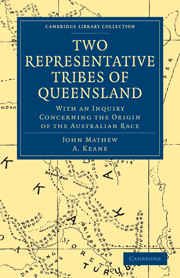 Two Representative Tribes of Queensland
Two Representative Tribes of Queensland Book contents
- Frontmatter
- Contents
- LIST OF ILLUSTRATIONS
- INTRODUCTION
- PREFACE
- CHAP. I INQUIRY CONCERNING THE ORIGIN OF THE AUSTRALIAN RACE
- CHAP. II THE COUNTRY OF THE KABI AND WAKKA TRIBES
- CHAP. III PHYSICAL AND MENTAL CHARACTERS
- CHAP. IV DAILY LIFE—SHELTER—FOOD—CLOTHING
- CHAP. V MAN-MAKING AND OTHER CEREMONIES
- CHAP. VI DISEASE AND TREATMENT—DEATH—BURIAL AND MOURNING
- CHAP. VII ART—IMPLEMENTS—UTENSILS—WEAPONS—CORROBOREES
- CHAP. VIII SOCIAL ORGANISATION
- CHAP. IX THE FAMILY—KINSHIP AND MARRIAGE
- CHAP. X RELIGION AND MAGIC
- CHAP. XI MYTHS AND LEGENDS
- CHAP. XII LANGUAGE
- VOCABULARY
CHAP. VI - DISEASE AND TREATMENT—DEATH—BURIAL AND MOURNING
Published online by Cambridge University Press: 29 August 2010
- Frontmatter
- Contents
- LIST OF ILLUSTRATIONS
- INTRODUCTION
- PREFACE
- CHAP. I INQUIRY CONCERNING THE ORIGIN OF THE AUSTRALIAN RACE
- CHAP. II THE COUNTRY OF THE KABI AND WAKKA TRIBES
- CHAP. III PHYSICAL AND MENTAL CHARACTERS
- CHAP. IV DAILY LIFE—SHELTER—FOOD—CLOTHING
- CHAP. V MAN-MAKING AND OTHER CEREMONIES
- CHAP. VI DISEASE AND TREATMENT—DEATH—BURIAL AND MOURNING
- CHAP. VII ART—IMPLEMENTS—UTENSILS—WEAPONS—CORROBOREES
- CHAP. VIII SOCIAL ORGANISATION
- CHAP. IX THE FAMILY—KINSHIP AND MARRIAGE
- CHAP. X RELIGION AND MAGIC
- CHAP. XI MYTHS AND LEGENDS
- CHAP. XII LANGUAGE
- VOCABULARY
Summary
Before they became tainted with diseases contracted from Europeans, the aborigines were a healthy and hardy race. Their outdoor life and the necessary struggle for existence kept them toned up physically. No epidemics are known to have occurred. Their maladies were such as would arise from accident, exposure, strain and errors of diet. Indigestion, rheumatism and toothache were common troubles. Leprosy was unknown, but I knew the case of a man whose nose was in a state of chronic gangrene. Heart disease, probably the result of strain, judging from cases I witnessed, would not be rare. The partial adoption of European habits both aggravated the maladies they were naturally liable to and induced others of a more serious nature, such as syphilis and phthisis. Since contact with white people, the great majority of deaths has been the result of phthisis, and this scourge has been specially fatal to the young.
In their pristine condition the natives seemed to have lived to an old age. I knew a few people of seventy years and upwards. One woman, who used to be carried about from camp to camp, had become wizened like a mummy.
Their medical skill was very limited, for the most part mere illusion, and of surgical skill they had virtually none. To allay pain they would apply a tight bandage, and sores they would cover over with clay or ashes.
- Type
- Chapter
- Information
- Two Representative Tribes of QueenslandWith an Inquiry Concerning the Origin of the Australian Race, pp. 110 - 116Publisher: Cambridge University PressPrint publication year: 2010First published in: 1910


